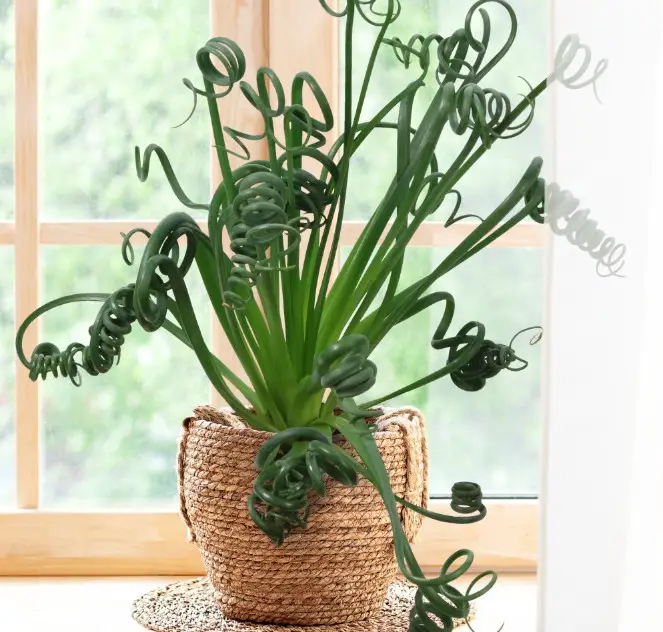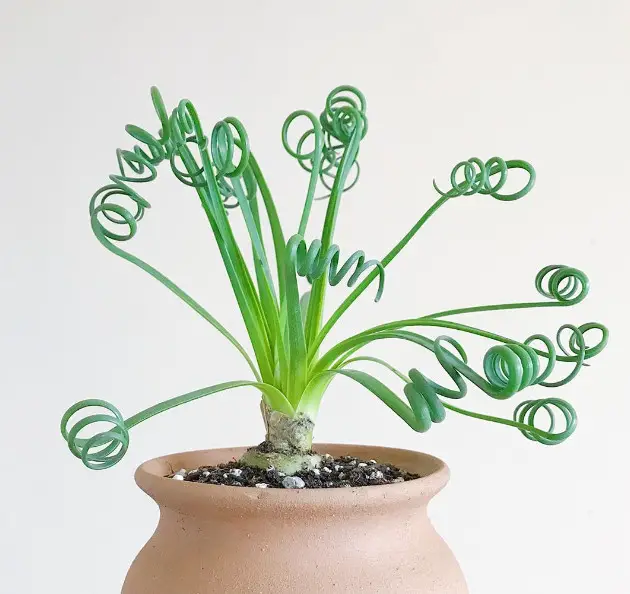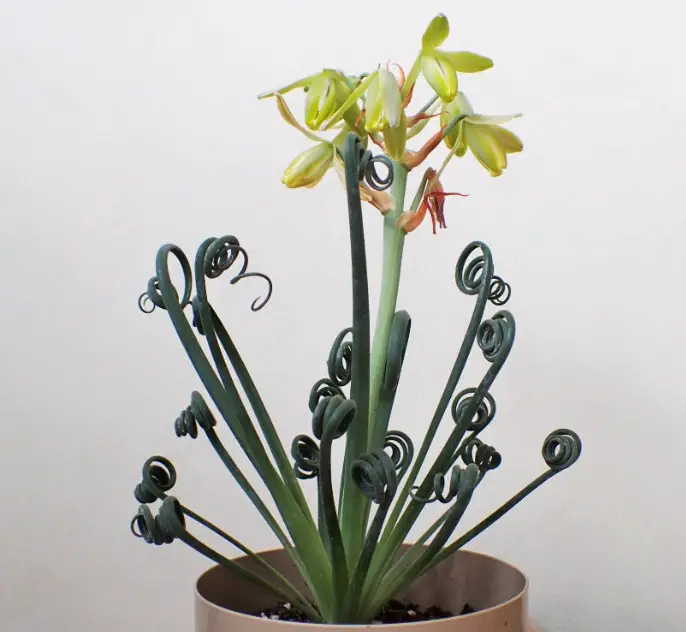Are you enticed by the exotic appeal of the Frizzle Sizzle Plant, also known as Albuca Spizzleis? This interesting botanical specimen adds a unique touch to any garden or indoor space. In this article, we’ll explore everything you need to know to successfully grow and care for the Frizzle Sizzle Plant.
About Frizzle Sizzle Plant

Frizzle sizzle, scientifically known as Albuca spiral, is a plant in the Asparagus family. Its common name perfectly captures its unique appearance, characterized by spiraling foliage that gives it an enchanting and whimsical appearance. This succulent grows from tubers and reaches a mature height of about 8 inches.
One of the notable features of Frizzle sizzle is its ability to adapt to many different lighting conditions. It thrives in both full and partial sun exposure, making it suitable for many indoor and outdoor environments. Regarding soil preferences, this plant prefers moist environments but needs well-drained soil to avoid waterlogging. It favors neutral soil pH levels.
During the winter months, Frizzle sizzle blooms, boasting clusters of bright yellow flowers that add a cheerful touch to the surrounding landscape. This blooming period adds beauty to this already captivating plant.
Frizzle sizzle is best suited to USDA hardiness zones 9-11, indicating it prefers warmer climates. Native to Africa, it takes on an exotic flair wherever it is grown. Whether used as an accent in garden beds or as an addition to indoor collections, Frizzle sizzle never fails to impress with its quirky appearance and approachable nature.
Frizzle Sizzle Plant Care

The key to properly caring for Frizzle Sizzle plants is being aware of their unique needs and natural habitat. If given the right attention, these oddball plants can even produce adorable, colorful, hanging blossoms with a delicious vanilla-and-butter aroma.
Frizzle Sizzle, sometimes referred to as Albuca spiralis, is a plant that emerges from its bulb coiled within the genus Albuca, which is home to about 100 different plant species. For the bulb to produce strong foliage and eventual flowers, a chilling phase is necessary. But growing Frizzle Sizzle indoors might be difficult because they need lots of sunlight to grow well.
Frizzle Sizzle plants are a little tricky for novice gardeners since they have specific requirements regarding drainage and watering. It’s also important to remember that, under ideal growing conditions, Albuca spiralis normally takes around 12 weeks to achieve full maturity.
Frizzle Sizzle plants require a minimum temperature of 60°F to be healthy, while they normally do better in somewhat warmer areas. For these fascinating plants, winter is the perfect growth season since it provides the conditions they need to thrive.
Light
Frizzle Sizzle plants thrive when exposed to ample sunlight, making them ideal candidates for locations with full or partial sun exposure. They typically require a minimum of five to seven hours of sunlight each day to ensure robust growth and vibrant foliage.
However, it’s essential to provide Frizzle Sizzle with the right kind of light. While they benefit from bright, indirect light, excessive exposure to intense sunlight can lead to leaf burn. Therefore, placing them in a spot with filtered sunlight or using sheer curtains to diffuse direct sunlight is recommended.
For indoor cultivation, a south-facing window often provides the perfect balance of brightness and indirect light, making it an ideal location for Frizzle Sizzle plants.
Soil
When it comes to soil requirements, Frizzle Sizzle plants, being succulents, thrive in a loose and well-draining potting mix. Opting for a cactus or succulent mix is highly recommended, as these mixes are specifically formulated to provide the fast-draining conditions that succulents like Frizzle Sizzle require. These mixes often contain materials such as sand and perlite, which facilitate proper drainage and aeration for the roots.
It’s crucial to avoid tightly packing the potting mix around the plant, as this can impede the development of roots and lead to issues such as root rot. Instead, gently fill the pot with the soil mix, allowing it to settle naturally around the plant without compacting it excessively.
Water
Proper watering is essential for the health and vitality of Frizzle Sizzle plants, as they have specific requirements that must be met to thrive.
During the active growing season, it’s crucial to water Frizzle Sizzle plants regularly, but caution must be exercised to avoid overwatering, which can lead to bulb rot. The frequency of watering will vary depending on factors such as ambient temperature, humidity, and soil composition. In general, watering the plant approximately once per week is recommended. However, if the soil dries out more rapidly due to environmental conditions, you may need to water more frequently.
Conversely, if it takes longer than a week for the soil to dry out, it indicates that either the plant is being watered too deeply or that the potting mix is retaining excessive moisture. In such cases, adjustments should be made to prevent waterlogging and ensure proper drainage.
During the dormancy period, which typically occurs in colder months or when growth slows down, watering frequency should be reduced. In this phase, watering Frizzle Sizzle plants every 3 to 4 weeks is sufficient, ensuring that the soil is allowed to dry out completely between waterings. This approach helps prevent issues such as root rot and promotes the plant’s overall health during periods of reduced activity.
Temperature and Humidity
Maintaining appropriate temperature and humidity levels is crucial for the well-being of Frizzle Sizzle plants, ensuring optimal growth and development.
Frizzle Sizzle plants thrive within a temperature range of approximately 60 to 75 degrees Fahrenheit. This moderate temperature range provides the ideal conditions for these plants to flourish. Exposure to slightly cooler temperatures, around 50 degrees Fahrenheit, can stimulate the bulb to emerge from dormancy, signaling the onset of the growing season.
For outdoor cultivation, Frizzle Sizzle plants are hardy in USDA growing zones 9 to 11. These zones encompass regions with relatively mild climates, where temperatures typically remain within the preferred range for Frizzle Sizzle plants throughout the year. However, in regions with colder climates, it may be necessary to provide protection or bring the plants indoors during periods of frost or extreme cold to prevent damage.
Maintaining appropriate humidity levels can also contribute to the overall health and vigor of Frizzle Sizzle plants. While they can tolerate a range of humidity levels, providing moderate humidity levels, around 40-60%, can help create an optimal growing environment, especially in indoor settings.
Fertilizer
To ensure optimal growth and development, it’s important to fertilize Frizzle Sizzle plants during their active growing period. Using a well-balanced liquid fertilizer, such as a 10-10-10 formula, provides essential nutrients that support healthy foliage and vibrant blooms.
During the fall, when Frizzle Sizzle plants typically show signs of growth, it’s advisable to begin fertilizing them on a monthly basis. Applying the liquid fertilizer to damp soil is ideal, as it allows for better absorption by the plant’s roots. Therefore, timing the fertilizer application immediately after watering is recommended to maximize its effectiveness.
Propagating Frizzle Sizzle
Propagating Frizzle Sizzle plants offers an opportunity to expand your collection and share their unique beauty with others. There are two primary methods for propagating these plants: through seeds and bulbs.
To propagate Frizzle Sizzle plants from seeds, start by planting the seeds at a depth no greater than twice their size. Mist the soil to keep it damp, but be careful not to saturate it, as excessive moisture can hinder germination. Place the seeds in a sunny location to ensure they remain warm enough for successful germination. It’s essential to plant the seeds within six months of harvesting to maintain their viability.
Alternatively, propagating Frizzle Sizzle plants through bulbs involves carefully separating a healthy bulb or cluster of bulbs from the parent plant. Ensure that each bulb has intact roots before replanting it as a new individual. If propagating through division, separate the cluster of bulbs into smaller groups before replanting to encourage healthy growth.
Pests and disease problems
Unlike many other plants, including succulents, Frizzle Sizzle rarely encounters problems related to pests or diseases, making it an exceptionally low-maintenance option for gardeners.
However, it’s worth noting that during the blooming season, when Frizzle Sizzle produces its distinctive flower stalks, the tips of its curly leaves may turn brown. To mitigate this issue, promptly remove the flowers as soon as they begin to emerge, helping to preserve the plant’s aesthetic appeal.
Additionally, if you notice the green leaves of Frizzle Sizzle drying up and falling off, there’s no cause for alarm. This occurrence signifies the onset of the plant’s dormancy period, typically during the summer months. During dormancy, Frizzle Sizzle sheds its leaves and remains inactive until the winter season. However, as long as the bulb remains healthy, the plant will regrow its leaves once dormancy ends, typically in winter.
While Frizzle Sizzle may experience minor aesthetic changes during certain stages of its growth cycle, its resilience against pests and diseases makes it an excellent choice for both beginner and experienced gardeners alike.
How is Frizzle Sizzle supposed to bloom?

During late winter to spring, Albuca ‘Frizzle Sizzle’ may begin to produce stalks bearing drooping, creamy yellowish-green vanilla-scented flowers. These flower stalks can grow to heights of about 12 to 24 inches and typically feature 10 to 20 blooms per spike.
As the plant enters its flowering phase, you may notice that the tips of its leaves start to turn brown or dry. While this is a natural process for the plant, if you find the brown or dry tips unsightly, you can take action to address them. Simply pinch away the affected areas, or if you prefer to prevent browning altogether, you can opt to remove the flower stalks as soon as they begin to emerge.






